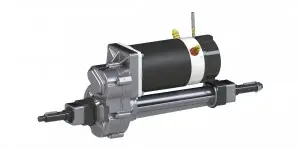The Role of Recycling in Reducing Lifecycle Emissions of Electric Transaxles
Introduction
As the world transitions towards sustainable transportation, electric vehicles (EVs) have emerged as a crucial solution to reduce greenhouse gas emissions and combat climate change. Central to the functionality and efficiency of EVs is the electric transaxle, a complex assembly that integrates the electric motor, transmission, and differential into a single unit. This integration not only enhances the performance and efficiency of the vehicle but also plays a significant role in determining its overall environmental impact. One of the critical aspects of mitigating this impact is the recycling of electric transaxles.
Lifecycle Emissions of Electric Transaxles
To understand the role of recycling, it is essential to first comprehend the lifecycle emissions associated with electric transaxles. The lifecycle of an electric transaxle can be broadly divided into three phases: production, use, and end-of-life. Each phase contributes to the overall carbon footprint of the component.
Production Phase
The production phase includes the extraction of raw materials, manufacturing processes, and assembly of the electric transaxle. This phase is energy-intensive and contributes significantly to the initial carbon emissions of the component. The extraction and processing of metals such as copper, aluminum, and rare earth elements used in electric motors and other components require substantial energy inputs, leading to carbon emissions. Additionally, the manufacturing processes, including casting, machining, and assembly, further add to the environmental impact.
Use Phase
The use phase of an electric transaxle is primarily associated with the operation of the electric vehicle. While EVs are known for their lower emissions compared to internal combustion engine vehicles, the overall emissions during the use phase depend on the source of electricity used to charge the vehicle. If the electricity grid is powered by renewable sources, the emissions are significantly lower. However, if the grid relies heavily on fossil fuels, the emissions can be higher. Despite this, the use phase generally contributes the most to the lifecycle emissions of the vehicle, highlighting the importance of optimizing vehicle-grid interactions and promoting renewable energy sources.
End-of-Life Phase
The end-of-life phase encompasses the disposal, recycling, and potential reuse of the electric transaxle. Traditionally, the disposal of automotive components has led to significant environmental impacts due to landfilling and incineration. However, recycling offers a more sustainable alternative by recovering valuable materials and reducing the need for new raw materials. This not only conserves natural resources but also reduces the carbon emissions associated with their extraction and processing.
The Role of Recycling
Recycling plays a pivotal role in reducing the lifecycle emissions of electric transaxles. By recovering and reusing materials from end-of-life components, recycling helps mitigate the environmental impact across multiple stages of the lifecycle.
Material Recovery and Reuse
One of the primary benefits of recycling electric transaxles is the recovery of valuable materials such as copper, aluminum, and rare earth elements. These materials can be reused in the production of new components, thereby reducing the demand for virgin materials. For instance, recycling lithium from electric vehicle batteries can significantly reduce the need for new lithium mining, which is an energy-intensive and environmentally impactful process. Similarly, the recovery of copper and aluminum can help conserve these finite resources and reduce the carbon emissions associated with their production.
Reducing Raw Material Demand
By recycling electric transaxles, the demand for new raw materials can be significantly reduced. The extraction and processing of raw materials are often the most carbon-intensive stages of a product’s lifecycle. Recycling helps close the loop, creating a circular economy where materials are continuously reused, thereby reducing the environmental impact of raw material extraction. For example, in an ideal scenario where all metals are 100% recycled, the cumulative recycled cobalt and nickel could reduce raw material production by at least 66.3%. This not only conserves natural resources but also reduces the carbon emissions associated with their extraction and processing.
Lowering Lifecycle Carbon Emissions
Recycling electric transaxles can lead to significant reductions in lifecycle carbon emissions. Studies have shown that recycling can reduce the overall carbon footprint of electric vehicle components by a considerable margin. For instance, recycling retired batteries can reduce life-cycle carbon emissions by up to 4.7% without second use, and this potential increases to 37.9% with 100% second use. This highlights the importance of recycling in mitigating the environmental impact of electric transaxles.
Second Use and Extended Lifecycle
In addition to recycling, the second use of electric transaxles and their components can further extend their lifecycle and reduce emissions. For example, retired batteries can be repurposed for stationary energy storage, reducing the need for new batteries and lowering the overall carbon footprint. Similarly, electric transaxles can be remanufactured and reused in other vehicles, thereby extending their useful life and reducing the demand for new components.
Challenges and Opportunities
While recycling offers significant benefits in reducing lifecycle emissions, several challenges need to be addressed to maximize its potential.
Technological Limitations
One of the primary challenges in recycling electric transaxles is the complexity of the components and the presence of hazardous materials. Advanced recycling technologies are required to safely and efficiently dismantle and recycle these components. For example, the recovery of rare earth elements from electric motors is technically challenging and requires specialized processes.
Post time: Jul-18-2025


